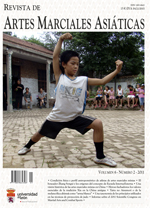Born to fight? Genetics and combat sports
DOI:
https://doi.org/10.18002/rama.v9i1.1000Keywords:
Gene, polymorphisms, sports performanceAgencies:
Conselho Nacional de Desenvolvimento Científico e Tecnológico - CNPq (236768/2012-3)Abstract
Recently, the influence of genetics on sports performance has received increased attention from many researchers. In combat sports, some investigations have also been conducted. This article’s main objective was to review the representation of specific gene polymorphisms in combat sports athletes compared to controls. The following databases were searched: PubMed, Web of Science and SportDiscus. The terms used in this search involved combat sports (boxing, karate, judo, mixed martial arts, taekwondo and wrestling), genes, genetics and candidate genes. Articles published until November 2013 were included if combat sports athletes were considered as a single group (i.e., not mixed with athletes of other sports). Seven studies were found, with two presenting no difference between combat sports athletes and controls, two presenting higher frequencies of candidate genes related to a more endurance-related profile compared to controls, and three where a more power-related gene overrepresentation was found in comparison to controls. Taken together, the initial studies about the genetic characteristics of combat sports athletes are controversial, which is probably due to the mixed (aerobic and anaerobic) characteristic and to the multifactorial performance determinants of these sports.Downloads
Métricas alternativas
References
Ahmetov, I. I., Mozhayskaya, I. A., Flavell, D. M., Astratenkova, I. V., Komkova, A. I., Lyubaeva, E. V., ... Rogozkin, V. A. (2006). PPAR alpha gene variation and physical performance in Russian athletes. European Journal of Applied Physiology, 97(1), 103-108.
Andreato, L. V., Moraes, S. M. F., Esteves, J. V. C., Pereira, R. R. A., Gomes, T. L. M., Andreato, T. V., Franchini, E. (2012). Physiological responses and rate of perceived exertion in Brazilian jiu-jitsu athletes. Kinesiology, 44(3), 173-181.
Avelar, B., Figueiredo, A. (2009). La iniciación a los deportes de combate: Interpretación de la estructura del fenómeno lúdico luctatorio. Revista de Artes Marciales Asiáticas, 4(3), 44-57.
Beneke, R., Beyer, T., Jachner, C., Erasmus, J., Hütler, M. (2004). Energetics of karate kumite. European Journal of Applied Physiology, 92(4-5), 518-523.
Campos, F. A. D., Bertuzzi, R., Dourado, A. C., Santos, V. G. F., Franchini, E. (2012). Energy demands in taekwondo athletes during combat simulation. European Journal of Applied Physiology, 112(4), 1221-1228.
Cieszczyk, P., Maciejewska, A., Sawczuk, M., Ficek, K., Eider, J., Jascaniene, N. (2010). The angiotensin converting enzyme gene I/D polymorphism in elite Polish and Lithuaninan judo players. Biology of Sport, 27(2), 119-122.
Cieszczyk, P., Sawczuk, M., Maciejewska, A., Ficek, K., Eider, J. (2011). Variation in peroxisome proliferator activated receptor gene in elite combat athletes. European Journal of Sport Science, 11(2), 119-123.
Ehlert, T., Simon, P., Moser, D. A. (2013). Epigenetics in sports. Sports Medicine, 43(2), 93-110.
Fedotovskaya, O., Eider, J., Cieszczyk, P., Ahmetov, I., Moska, W., Sawczyn, S., … Jascaniene, N. (2013). Association of muscle-specific creatine kinase (CKM) gene polymorphism with combat athlete status in Polish and Russian cohorts. Archives of Budo, 9(3), 233-237.
Franchini, E., Takito, M. Y., Bertuzzi, R. C. M. (2005). Morphological, physiological and technical variables in high-level college judoists. Archives of Budo, 1(1), 1-7.
Franchini, E., Del Vecchio, F.B., Matushigue, K.A., Artioli, G.G. (2011). Physiological profiles of elite judo athletes. Sports Medicine, 41(2), 147-166.
Franchini, E., Brito, C. J., Artioli, G. G. (2012). Weight loss in combat sports: physiological, psychological and performance effects. Journal of the International Society of Sports Nutrition, 9(1), 52.
Franchini, E., Artioli, G. G., Brito, C. J. (2013). Judo combat: time-motion analysis and physiology. International Journal of Performance Analysis in Sport, 13(3), 626-643.
Gariod, L., Favre-Juvin, A., Novel, V., Reutenauer, H., Majean, H., Rossi, A. (1995). Évaluation du profil énergétique des judokas par spectroscopie RMN du P31. Science & Sports, 10(4), 201-207.
Gonçalves, C. E. B., Rama, L. M. L., Figueiredo, A. B. (2012). Talent identification and specialization in sport: an overview of some unanswered questions. International Journal of Sports Physiology and Performance, 7(4), 390-393.
Kikuchi, N., Min, S. K., Ueda, D., Igawa, S., Nakazato, K. (2012). Higher frequency of the ACTN3 R allele + ACE DD genotype in Japanese elite wrestlers. Journal of Strength and Conditioning Research, 26(12), 3275-3280.
Kikuchi, N., Ueda, D., Min, S. K., Nakazato, K., Igawa, S. (2013). The ACTN3 XX genotype’s underrepresentation in Japanese elite wrestlers. International Journal of Sports Physiology and Performance, 8(1), 57-61.
Kordi, R., Maffulli, N., Wroble, R. R., Wallace, A. (2009). Combat sports medicine. London: Springer.
Lombardo, M. P. (2012). On the evolution of sport. Evolutionary Psychology, 10(1), 1-28.
Lucía, A., Morán, M., Zihong, H., Ruiz, J. R. (2010). Elite athletes: are the genes the champions? International Journal of Sports Physiology and Performance, 5(1), 98-102.
Moreno, E. (2011). The society of our “out of Africa” ancestors (I) – the migrant warriors that colonized the world. Communicative & Integrative Biology, 4(2), 163-170.
Moreno, E. (2013). The “out of Africa tribe” (II) – paleolithic warriors with big canoes and protective weapons. Communicative & Integrative Biology, 6(3), e24145.
Rodríguez-Romo, G., Yvert, T., Diego, A., Santiago, C., Durana, A. L. D. Carratalá, V., … Lucia, A. (2013). No association between ACTN3 R577X polymprphism and elite judo athletic status. International Journal of Sports Physiology and Performance, 8(5), 579-581.
Smith, D. J. (2003). A framework for understanding the training process leading to elite performance. Sports Medicine, 33(15), 1103-1126.
Yoon, J (2002). Physiological profiles of elite senior wrestlers. Sports Medicine, 32(4), 225-233.
Downloads
Published
How to Cite
Issue
Section
License
Copyright (c) 2014 Emerson Franchini

This work is licensed under a Creative Commons Attribution-NonCommercial-ShareAlike 4.0 International License.
The authors who publish in this journal must agree to the following terms:
- The authors grant on a nonexclusive basis the exploitation rights (reproduction, distribution, public communication and transformation) of the work accepted for publication to the University of León. The authors can establish, on their own, additional agreements for the non-exclusive distribution of the version of the work published in the journal (for example, placing it in an institutional repository or publishing it in a book), always acknowledging the initial publication in this journal.
- This work is licensed under the Creative Commons Attribution-NonCommercial-ShareAlike 4.0 International License. Click to see basic information and the legal text of the license.
- The authors are allowed and encouraged to disseminate electronically pre-print or post-print versions of their work before publication, as this can give rise to productive exchanges, as well as earlier and increased citing of the works published.











